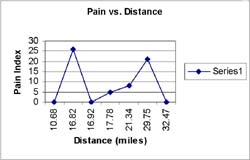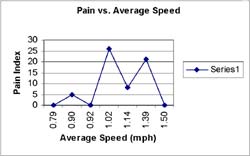Manual Wheelchair Use and Reported Pain
Abstract
Manual wheelchair use has been shown to lead to a high incidence of pain. Pain can occur in areas such as the upper extremities, back and neck. Pain may affect mobility patterns of the wheelchair users due to the desire to avoid activities that exacerbate pain. This study compares wheelchair usage and reported pain. Seven subjects were analyzed for average speed and distance traveled. The participants also completed McGill Pain Questionnaires. The farthest distance traveled was 32.47 miles over 5 days and the maximum average speed traveled was 1.50 miles per hour. A Pearson correlation analysis between reported pain and distance and reported pain and speed showed little correlation with coefficients of 0.145 and 0.215 respectively.
Keywords
Manual wheelchairs, pain
Background
The very nature of manual wheelchair use can be very stressful on the body of the user. The arms of humans were not made to move the weight of the body around all the time. The joints in the arms end up being used excessively resulting in injuries that cause the user to experience pain. These injuries can include carpal tunnel syndrome, shoulder impingement and premature shoulder joint degeneration 1 . Another source of pain in manual wheelchair users is at the neck and lower back. The causes of this pain include poor posture, exposure to vibration, and use of the arms above the height of the shoulder 2 . It has been reported that as many as 94% of people with spinal cord injury report pain 3 . This pain may be so severe or disabling that it affects physical functioning in 30-40% 3 of individuals. Having a better understanding of how pain correlates to and affects wheelchair usage may give users a better understanding on how to manage pain.
Research Question
Is there a correlation between the amount of manual wheelchair usage and the amount of pain reported by the user? Manual wheelchair use causes repetitive strain injuries but do users who are more active report higher levels of pain then those less active?
These questions offer a starting place for study of pain in manual wheelchair users. If higher amounts of usage cause more injury and thus more pain, manual wheelchair users that travel greater distances will report higher levels of pain.
Methods
Using small devices, dataloggers, the usage of manual wheelchair users was monitored. Through the data recorded by these devices the distance, speed and time of travel of each wheelchair user was calculated.
A TFX-11 datalogger was attached to each participant's wheelchair. A switch was attached to the frame of the chair and a magnet was bolted to the wheel. As the magnet passed the switch the date and time were recorded by the datalogger. Using MatLab, along with the wheel diameter of the chair, the average speed per hour and distance traveled per hour was calculated. Pain data were collected using a survey that included a section of the McGill Pain Questionnaire relevant to this study.
Seven participants in a National Veterans Wheelchair Games completed both the datalogger collection and provided pain information. The data were collected at the Wheelchair Games in New York, Cleveland, OH, and Long Beach, CA. For six of the subjects the pain data were collected at the same time that they participated in the datalogger collection. However, one of the subjects completed the pain questionnaire the year before participating in the datalogger study. The average age of participants was 45 +/- 8.9 years old with a range of 30-55.
The data were statistically analyzed using Pearson correlation. It was analyzed for a correlation between both recorded pain and speed and also recorded pain and distance. SPSS was used to find the correlation coefficient.
Results
 |
 |
The pain data were analyzed in relation to both distance and speed. When comparing reported pain and distance the Pearson correlation coefficient was 0.145. When comparing pain and speed the Pearson correlation coefficient was 0.215. Therefore neither speed or distance traveled was found to be significantly correlated with pain in this sample of manual wheelchair users. The figures below show a graphical representation of reported pain versus distance and reported pain versus speed.
Discussion
The data from these studies indicate very little correlation between usage and reported pain. However the amount of subjects studied for this study may be too few to clearly get an understanding of how wheelchair usage and reported pain connect. A power calculation was run in order to estimate how many subjects would need to be tested in order to have an 80% chance of finding a correlation. The results showed that about 500 subjects would be needed. It may also be important to understand how long the user has been experiencing the amount of pain. Usage habits may change over time the longer someone is dealing with pain. As this was a cross-sectional study, there is no means to determine causality. Subjects may have reduced their activity due to pain or prolonged activity may cause pain. The specific relationship has yet to be determined.
There are several theories on how pain correlates with usage. The first being that if the user has high amounts of pain he or she will not travel as fast or as far. The pain will inhibit the users activities. The user will be less active because high levels of activity will cause high amounts of pain. In order to avoid this level of pain the user will move slower and not go as far.
Another theory is that the higher the amount of activity the higher the amount of reported pain. This theory is opposite of the one mentioned above. If pain, especially in the shoulders, is caused by high levels of activity then those traveling the greater distance and moving at higher speeds will experience more pain.
The third theory is that no matter how much pain a manual wheelchair user has it is not going to significantly change the usage habits. A wheelchair user still has to continue with the daily activities of life even if they are experiencing pain. They have to continue to work or go to school and other daily activities such as grocery shopping and other errands.
Conclusions
When comparing manual wheelchair use and reported pain there seems to be no correlation between the two. Neither distance traveled nor average speed had an influence on the amount of pain reported by the user. Users traveling a greater distance did not report higher amounts of pain than those who traveled a smaller distance. Nor did those traveling a smaller distance report a higher amount of pain than those who traveled a greater distance. Speed also had no bearing on reported pain in our sample. However, a higher number of participants may show different results.
References
- Ebihara K, Koontz A, Cooper R, Impink B, Boninger M. Kinetic Analysis of Wheelchair Propulsion for Various Surface and Ramp Conditions. Proceedings of the RESNA 25 th International Conference; 2002 June 27-July1; Minneapolis (MN). Arlington (VA): RESNA Press; 2002. CD-ROM
- Boninger M, Cooper R, Fitzgerald S, Lin J, Cooper R, Dicianno B, Liu B. Investigating Neck Pain in Wheelchair Users. Am J Phys Med Rehabil 2003; 82(3):197-202.
- Martin Ginis K, Latimer A, McKechnie K, Ditor D, McCartney N, Hicks A, Bugaresti J, Craven B C. Using Exercise to Enhance Subjective Well-Being Among People With Spinal Cord Injury: The Mediating Influences of Stress and Pain. Rehabilitation Psychology 2003; 48(3):157-164.
- Hoover A, Cooper R, Ding D, Dvorznak M, Cooper R, Fitzgerald S, Boninger M. Comparing driving Habits of Wheelchair Users: Manual vs. Power. Proceedings of the RESNA 25 th International Conference; 2002 June 27-July1; Minneapolis (MN). Arlington (VA): RESNA Press; 2002. CD-ROM
Acknowledgements
This study was partially supported by the Veterans Affairs Center of Excellence on Wheelchairs and Related Technology (F2181C).
Author contact Information :
April Hoover, BS,
Human Engineering Research Laboratories,
VA Pittsburgh Healthcare System,
7180 Highland Drive, 151R-1,
Pittsburgh, PA 15206,
Office Phone (412) 365-4850
EMAIL: aeh1@pitt.edu
